 Strategic Communication Examples
Strategic Communication Examples
Your internal communication plan dictates your communication processes. Check out our 10 expertly-crafted steps to make the best of it.

.jpg)
Start planning smarter. Download your free internal communications plan template now!
Access NowIn an era of fast-paced innovation and evolving workplace dynamics, effective internal communication is a crucial element for the success of any organization. Whether it’s sharing important updates, inspiring company loyalty, fostering transparency, or driving collaborative culture, communication within an organization can make or break its overall performance.
We understand how important communication strategies are, so we will walk you through the concept of an internal communication plan. We’ll talk about its relevance and the key components that make it work and provide tips on how to create and implement a plan effectively. We’ll also discuss some of the challenges and solutions for internal communications planning, including the value of AI in the communication planning process. All of this will enable you to create smoother, more successful internal communications operations.
An internal communications or internal comms plan is a strategy used by companies to ensure accurate and effective communication among team members. It helps to drive employees to engage and do what is needed to create desired business outcomes.
Ultimately, it’s one of the key business tools we can use to foster a strong company culture and improve the way employees engage within the organization.
It’s not rocket science, but in reality, creating a culture of engagement isn’t easy. It takes effort, investment, and a well-thought-out plan of action. But Gallup’s most recent Q12 meta-analysis of employee engagement, published in May 2024 and last revised in July 2024, shows just how worthwhile efforts can be. It found that companies with highly engaged teams experience 23% higher profitability and 18% higher productivity in terms of sales.
In dramatic contrast, Gallup’s State of the Workplace: 2024 report shows that when employees aren’t engaged at work, the effects can be more damaging than one might imagine. They estimate in the report that low engagement costs the global economy an immense $8.9 trillion. That’s 9% of global gross domestic product (GDP). This is $1 trillion higher than in 2023.

A well-designed internal communications plan will provide a guide for the communications team. It will enable them to convey company news, updates, and other essential information. The methods used vary widely but can include a social intranet, video updates, social media, email communications, and a branded internal comms app.
A good, well-designed internal communications strategy or plan will outline communication goals, key stakeholders, communication channels, and smart objectives of the organization for a specific period of time. It is a critical component of wider communication and should be part of any initial communication planning.
Like all communication tools, an internal communication plan can be structured in different ways, depending on an organization’s goals. For instance, you may want a high-level strategic plan, or you may want to focus on measurable impact and incorporate metrics, leadership messaging, crisis response, change management, or employee engagement.
Using an internal communication plan template can help streamline efforts and ensure consistency. Ultimately, planning makes perfect, and in this scenario, effective planning will lead to clearer, more impactful communications.
Here are some internal communication plan examples.
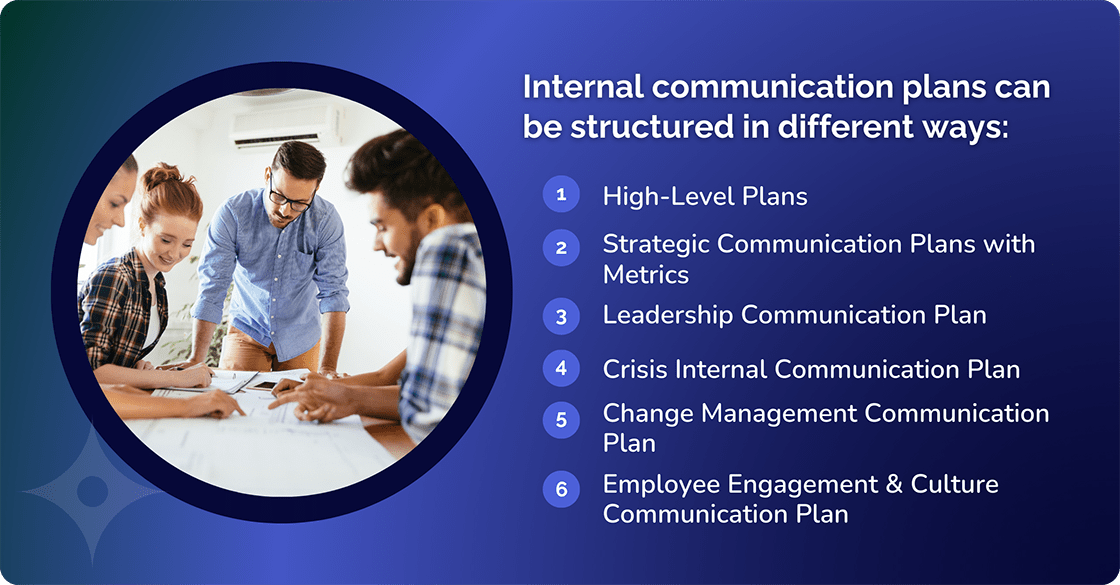
A high-level internal communication plan provides a broad, strategic view of communication initiatives, outlining the timeline and projects the internal communications team will tackle. It offers a big-picture perspective, ensuring that communication efforts align with organizational goals.
Using visuals such as roadmaps, Gantt charts, or dashboards makes this plan easier to understand and track progress. Here’s an example of the visual approach:
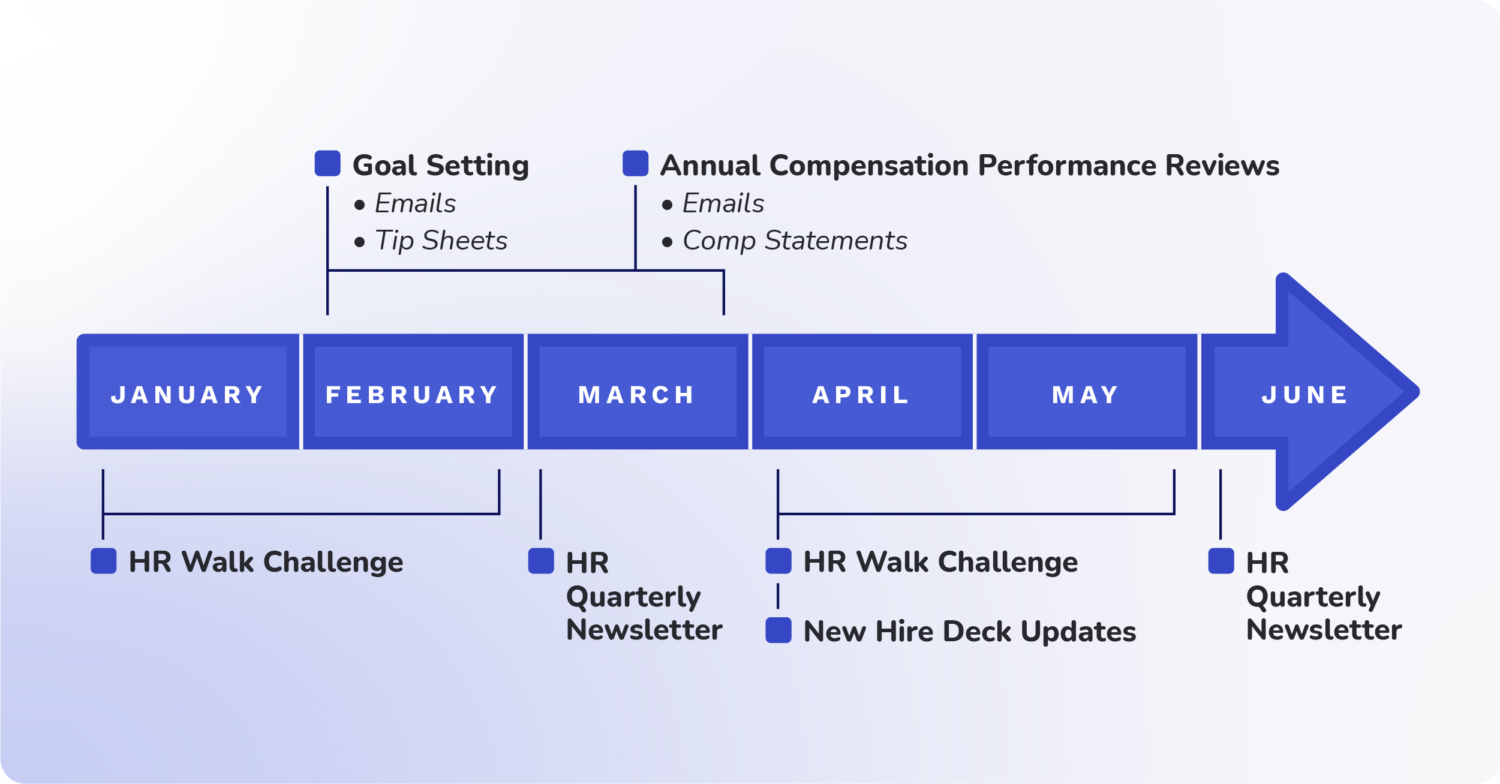
A strategic internal communication plan with metrics is a structured framework that defines how messages will be conveyed to employees while ensuring that success is measurable. It follows a similar process to a high-level plan but incorporates data-driven decision-making.
By incorporating metrics and analytics, this approach ensures ongoing optimization and demonstrates the ROI of internal communications efforts.
Leadership plays a crucial role in building and executing an effective internal communication plan. Not only are leaders responsible for framing strategies, but they also ensure that communication goals are met with equal vigor at every level. The communications team relies heavily on their team leaders for guidance and support.
A leadership communication plan ensures that messages from executives and managers are consistent, transparent, and aligned with the organization’s vision and goals. Strong leadership communication fosters trust, engagement, and clarity, helping employees understand strategic priorities.
A well-structured leadership communication plan helps bridge the gap between executives and employees, ensuring that messages inspire, inform, and align teams with business goals.
An internal communications plan focused on resolving crises prepares organizations to respond quickly and effectively in times of emergencies, disruptions, or sensitive issues. It also ensures employees receive clear, timely, and accurate information, reducing uncertainty and preventing misinformation.
A strong internal crisis communication plan ensures transparency, reduces panic and maintains organizational stability during challenging times.
Effective communication is critical when managing organizational change, whether it’s a merger, restructuring a company, new technology rollout, or policy updates. A change management communication plan is vital for ensuring that employees understand, accept, and adapt to change smoothly.
With a well-structured change communication plan, employees are more likely to feel supported, engaged, and confident in navigating transitions.
An employee engagement and culture communication plan is designed to foster a positive, inclusive, and high-performance workplace culture by reinforcing company values, recognizing achievements, and encouraging employee participation.
By prioritizing engagement and cultural alignment, organizations can boost morale, enhance retention, and create a more connected workforce.
You can use a template to lay out your service delivery and support plan so that everyone has a clear understanding of the level of support your team will provide. A template-based approach streamlines the planning process, offering a structured framework that simplifies execution and improves alignment. By using a well-designed template, organizations can save time, reduce inefficiencies, and ensure their communication efforts drive meaningful engagement.
However, creating an internal communication plan template from scratch can be overwhelming. That’s why we’ve designed a beginner-friendly, intuitive, and optimized internal communication plan template to simplify the process. Whether you’re looking to streamline communication efforts or enhance alignment across teams, this ready-to-use template ensures clarity, structure, and measurable results.
Our template is designed with efficiency and ease of use in mind. It provides a clear framework for outlining objectives, key messages, and timelines, making it easier to plan, execute, and refine your communication strategy. With its structured approach, internal communicators can focus on engagement, alignment, and impact — without the guesswork.
This versatile tool is ideal for organizations of all sizes, helping teams develop a strategic, results-driven internal communication strategy or plan. It eliminates inefficiencies, allowing communicators to focus on what truly matters — delivering consistent, impactful messaging that drives employee engagement and organizational success.
As Gartner emphasizes, an internal communication plan is crucial for maintaining employee engagement and performance, especially during times of change, and helps align employee communications with business outcomes. It also helps to ensure that employees are informed and motivated to meet business goals, ultimately driving desired business outcomes.
Internal communications consultant, David Barber, couldn’t agree more. In an article, Do I really need an internal communications plan? He says, “In short, yes you do.”
“A plan means that you have visibility of all activity that’s going to be happening in your organization – this means that you can see when any ‘pinch points’ may be around the corner. You can plan for events before they happen, which will mean that they land much better.”
David Barber, Company Director, Spark Consultants
But that’s not all, he says. Once you’ve got the internal communication plan in place, you will start to see the benefits of:
Certainly, a clear and comprehensive internal communications strategy directly impacts job families in their current situation and assists in meeting targeted outcomes. It may sound confusing, but job families are simply different audience groups. Their mindsets are typically different and communication approaches will vary, depending on which group you are targeting. Examples include employees who work in different business units, those who are in different teams, as well as those who are on different levels (management, sales, customer service, and so on.)
Effective internal communications ensures that every team member is on the same page. It provides clarity about the company’s vision, its values, and the role each employee plays in achieving key objectives. Therefore, a strong internal communication strategy boosts overall employee engagement.
Effective internal communications are essential for ensuring that employees understand, support, and actively contribute to business goals and strategies. When employees are aligned with the organization’s vision, they feel more engaged, motivated, and invested in achieving success. Without this alignment, even the best internal communication strategy can fall flat due to miscommunication, uncertainty, or lack of direction.
One of the most effective ways to align employees is through transparent and consistent messaging from leadership. Regular updates, town halls, and personalized communication ensure that employees remain informed about the company’s objectives and their role in achieving them. Clear internal communications foster a sense of purpose, helping employees see how their daily tasks contribute to broader organizational goals.
Using data-driven insights and targeted messaging further enhances alignment. By segmenting messages based on departments, roles, or locations, internal communicators can ensure that employees receive relevant and actionable information tailored to their needs. Additionally, leveraging tools like AI-driven content personalization, engagement tracking, and pulse surveys allows organizations to measure alignment and make real-time adjustments to improve clarity and focus.
Ultimately, internal communications play a strategic role in bridging the gap between leadership vision and employee execution. When employees clearly understand and internalize business goals, they become proactive participants in driving growth, innovation, and overall success.
Consistency in internal communications is critical when it comes to building trust, credibility, and engagement within an organization. When messages are fragmented or inconsistent across different channels, employees may feel confused, disengaged, or misinformed. A well-defined internal communication strategy ensures that employees receive the same core messages across all platforms, reinforcing clarity and alignment.
A key component of message consistency is centralized communication planning. Organizations should establish clear guidelines for messaging, tone, and branding to maintain uniformity across emails, newsletters, intranet updates, leadership briefings, and team meetings. Standardized templates and messaging frameworks help internal communicators avoid contradictions, reinforce key messages, and prevent misinformation.
Technology also plays a major role in maintaining message consistency. AI-driven automation, content management systems, and communication analytics allow organizations to monitor messaging effectiveness, ensuring that all employees receive the same information regardless of location or department. Using tools like pre-scheduled communications and real-time updates ensures that messages are delivered in a timely, accurate, and consistent manner.
By maintaining a cohesive and unified communication strategy, organizations foster clarity, trust, and engagement among employees. When employees consistently hear and understand company messages, they feel more informed, connected, and empowered to contribute to organizational success.
An internal comms plan also plays a pivotal role in shaping a positive company or corporate culture. The key components of this workplace culture include fundamental principles and convictions that are important to the company. It incorporates the company’s mission and vision, establishes acceptable norms and behaviors in the workplace, and supports traditions and rituals like team building or recognition programs.
The behavior and leadership approach of top management can strongly influence the culture. Leaders set the tone for the organization by their actions, decisions, and communication style. Furthermore, a positive culture will engage employees more successfully. When employees feel a strong connection to the organization and its values, they are more likely to be motivated and satisfied in their roles. This, in turn, will impact positively on the organization’s bottom line.
Company or workplace culture can also encompass the organization’s approach to diversity, equity, and inclusion (DEI). A culture that values diversity and promotes inclusion is more likely to be seen as positive and forward-thinking.
A workplace culture should be developed to encourage openness, collaboration, and mutual respect. By promoting transparency and regularly sharing video updates, one can foster a sense of belonging and loyalty among team members.
An internal communication strategy will also help in crisis management. During a critical event, effective communication can alleviate anxiety, clear misconceptions, and guide employees with a systematic approach. There is no doubt that internal communications can be a lifesaver in challenging situations.
As mentioned earlier, a well-structured crisis communication plan ensures that employees receive timely, accurate, and transparent information, preventing confusion and misinformation. It establishes clear protocols for messaging, designated spokespersons, and multiple communication channels to reach employees wherever they are. By maintaining a steady flow of updates and providing avenues for feedback, organizations can reinforce trust, maintain stability, and empower employees to respond effectively to the situation at hand.
Organize communication objectives and create a clear, well-structured plan that you can adapt over time.
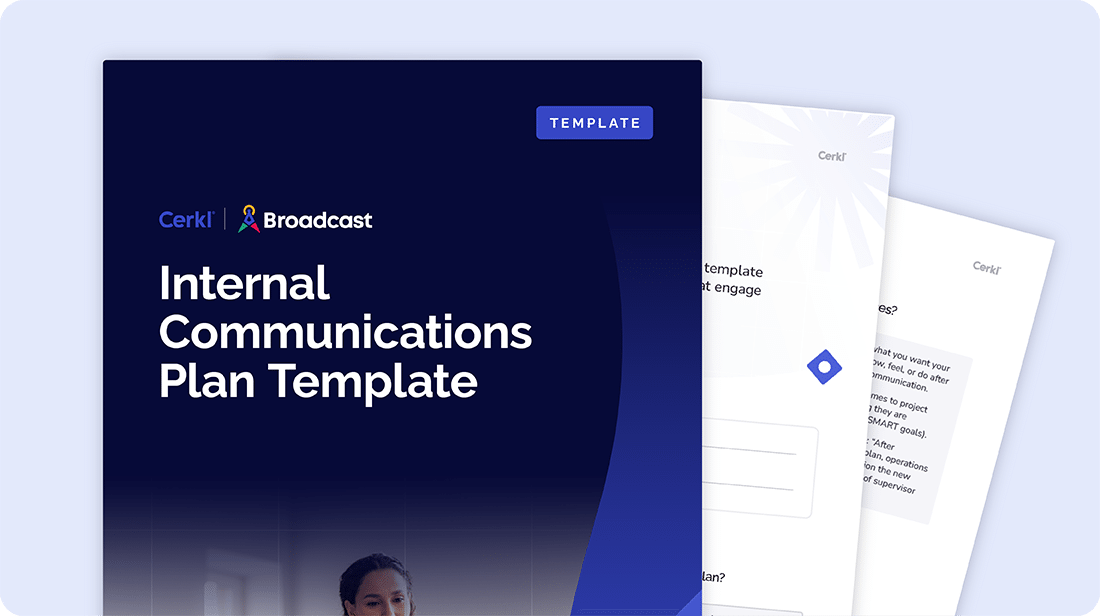
We’ve said that a strong internal comms plan can be the backbone of a strong company culture and enhanced employee engagement. Start with a thorough understanding of your current business situation, factor in your desired outcomes, and then determine your goals and objectives. Remember, your internal communication strategy needs to be flexible and responsive. Regular monitoring and adjustment are necessary to maintain its effectiveness and alignment with business objectives.
Here are 10 steps that will help you create the most effective internal communications plan for your organization.
Start by clearly defining what you want to achieve with your internal communication strategy. Why do you need a plan to increase and improve communication? What are your business needs and goals? Are there issues like low engagement with employees or new services or products that have prompted an increase in communication?
Once you have identified these objectives, they will guide your entire internal communication plan forward. But be sure to define your desired outcome. You really do need to be aiming at very specific goals.
Best Practice: Make sure your goals are SMART (Specific, Measurable, Achievable, Relevant, and Time-bound) for better clarity and effectiveness. There’s more about this later on.
Determine who your internal communication plan will be addressing. The reality is that different segments of your workforce may have different communication needs. Another important factor is that job families vary in different industries. For instance, those in the health industry will be very different from those in the banking sector.
Don’t confuse your target audience with stakeholders. Your audience is made up of those who will receive your messages. Stakeholders, on the other hand, are people and organizations that can influence outcomes.
Best Practice: Segment your audience based on job roles, departments, or any other relevant criteria to tailor your messages.
An internal communications audit is a must-have to gauge content consumption across your internal communications channels. It’s a best-practice review that you shouldn’t cut corners on. Begin by looking at your company’s content types and communications channels to gain valuable insights from employees and business partners.
Decide which communication channels are most suitable for reaching your audience. Consider a mix of channels, such as internal email, company intranet, team meetings, and social platforms.
Best Practice: Ensure your choice of channels aligns with your audience’s preferences and accessibility.
Plan what kind of content you are going to create and share. This can include news updates, project announcements, training materials, and just about anything you can create. But the value is in the message, so develop it carefully. Know what you want to share and make sure that it contains the facts and data to support your message.
Then you need to bring your message to life. That’s why the secret is to add anecdotal information and real-life stories to make them real.
Best Practice: Develop a content calendar to schedule and organize your messages throughout the year. Vary the content to make it appealing.
Timing is everything. So, create a timeline for when and how often you’ll communicate with employees. This ensures consistency in messaging. Having a project tracker will pay dividends.
It stands to reason that you should use the same plan for every new project. But timelines and message frequency may change.
Best Practice: Consider peak engagement times and events within your organization when scheduling communications.
Determine how you are going to measure the success of your internal communication strategy. This can include tracking open rates and employee surveys, as well as feedback analysis. Using a combination of these is good practice.
Best Practice: Use key performance indicators (KPIs) to gauge the effectiveness of your plan, and be open to adjusting your strategy based on feedback.
Prepare for unexpected situations by having an internal communication strategy geared for any possible crisis in place. This should include guidelines on how to communicate during emergencies or challenging times.
Business leaders need to focus on strength and stay positive in times of crisis. You also need to show your concern and be transparent to reassure employees. Additionally, you need to plan for an operational response, a management response, and ultimately a solid internal communications response.
Best Practice: Update your crisis communication plan regularly to stay responsive to evolving situations. And they will evolve all the time!
As always, there needs to be a chain of command. Clearly define who is responsible for each element within your internal communications plan. Assign roles and tasks to team members or departments.
Best Practice: Ensure everyone understands their responsibilities and knows how to collaborate effectively.
It is essential to provide training and resources for the communication team and ensure they understand the plan, tools, and best practices.
Best Practice: Encourage ongoing learning and skill development to stay up-to-date with evolving communication trends.
Before you schedule a full-scale launch, run a pilot phase to test your communication plan with a smaller group. Gather feedback and make necessary adjustments. Of course, to be able to do this, you need adequate advance planning and you must include this in your projected timeline.
Once you’re satisfied with the plan, launch it throughout your organization and begin executing it according to the schedule you have established.
Best Practice: Make sure all features and functionalities of chosen communication tools are working flawlessly. Then, when you launch, be sure to maintain consistency in your messaging and adhere to the established timeline.
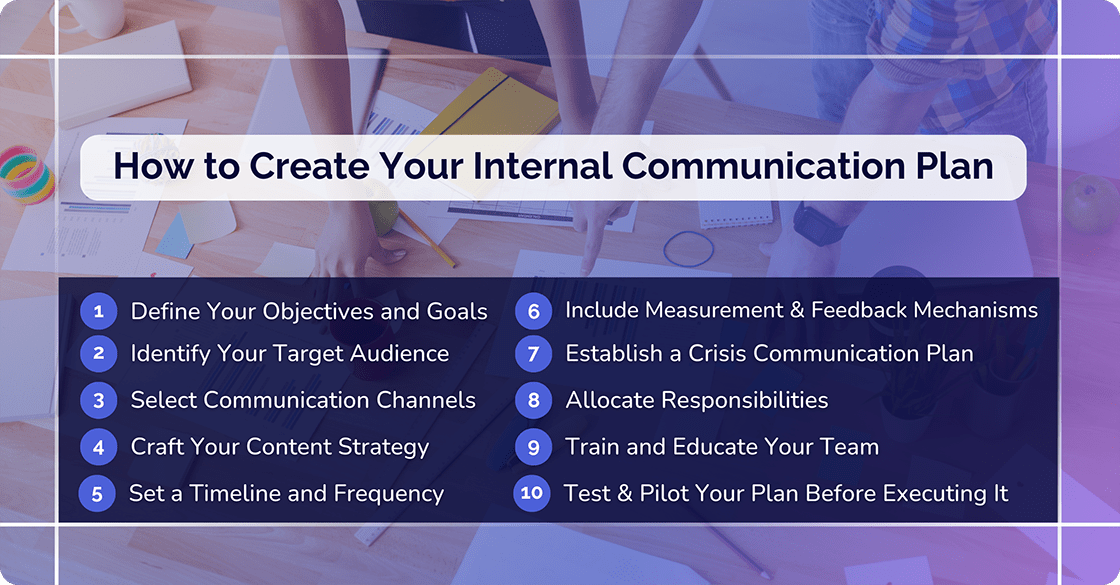
The creation of an internal communication plan can be an extremely effective approach to ensuring effective internal communication. It acts as a roadmap, providing a direct pathway between the desired outcome and the current situation in the company. When executed properly, an internal comms plan will establish a strong corporate culture, enhancing employee engagement, and boosting important organizational outcomes.
An excellent approach to setting up an effective internal comms plan is to focus on SMART goals and objectives. It’s a surprisingly simple approach based on the SMART acronym:

The SMART method helps to keep leaders, internal communicators, and everyone else involved motivated. It also provides a sense of direction and helps those in charge organize and reach the set goals.
These objectives should align with key business goals and be routed through the desired internal communications channels. Communication tactics, such as video updates or utilizing a social intranet, have the potential to disseminate these objectives broadly and comprehensively to all categories of employees.
A key element needed to execute an internal communication plan is an integrated and branded internal comms app. The internal communications SMART tool enables a broad-spectrum, wide, communication experience. It will ensure that comms reach all team members irrespective of location. It also brings about a sense of belonging, resulting in a strong company culture.
Every internal communication plan will inevitably have its own inherent challenges. White papers and scholarly articles often highlight common issues like lack of employee engagement, ineffective communication strategies, or inadequate use of communication tools. Recognizing these challenges makes it a lot easier to overcome them. It’s also good practice to explore solutions ahead of time.
One solution may be to shift to advanced, digital platforms like a social intranet or an internal communications app. Tools like these foster better communication strategies like video updates or podcasts for engaging a disconnected workforce and reinforcing a positive company culture.
Adhering to a strict privacy policy, while providing an employee engagement solution is another excellent practice for effective internal communication. It helps nurture trust among team members, potentially strengthening the bond among key stakeholders of the organization.
Monitoring and evaluation form the core of an internal communication strategy. It is an ongoing and cyclical process to examine whether communications have achieved the desired results and to explore areas that can be further developed.
The communications leader, together with the operating team, needs to encourage continuous feedback from employees about the current communication plan. Questions revolving around the frequency of communication, the effectiveness of internal communications channels, and the impact of communications on job families must be taken into consideration.
The evaluation phase of an internal communication strategy deals with assessing the inputs and suggestions gathered from employees. This is where metrics-driven decision-making comes into play. The leadership team, along with the internal communications team, evaluates the current communication strategies. It is not a static process, and it is essential to amend the process from time to time to get the desired outcome. Learn from your mistakes and build on your successes.
Effective internal communications are crucial for achieving organizational outcomes. When employees understand their company’s goals, they align their personal objectives with those of the organization. A robust internal communication plan fosters this alignment, ensuring clarity, consistency, and engagement across the workforce.
The communication plan is a key element in establishing a strong company culture, increasing employee engagement, and driving overall productivity. It defines the methods and channels through which messages are delivered, such as social media, company intranet, and video updates. However, the evolution of AI in 2025 has significantly enhanced how internal communications strategies are developed, executed, and optimized.
AI-powered tools now enable automated content personalization, sentiment analysis, and predictive analytics, ensuring employees receive relevant information at the right time. AI-driven automation also enhances efficiency by streamlining workflows, optimizing message timing, and identifying engagement trends. These capabilities allow internal communicators to craft data-driven, adaptive communication strategies that improve effectiveness and impact.
You may have developed the best content ever, but if it’s not delivered strategically and intelligently, it won’t have the desired effect. AI is transforming internal communication by ensuring precision, engagement, and real-time adaptability, making it an indispensable asset in modern communication planning.
Organize communication objectives and create a clear, well-structured plan that you can adapt over time.

Cerkl Broadcast offers a suite of AI-powered employee communication software suitable for any size organization, regardless of structure. Designed for internal communicators, it serves as a centralized hub for all communication assets, leveraging AI to automate workflows, optimize engagement, and enhance strategic planning. This ensures that communicators can easily access and manage information, making planning considerably more effective.
Broadcast’s AI-driven omnichannel capability is particularly effective. It removes the need to manually select the right channels for most communications, as the platform allows employees to set their preferred channels. This means all employees can access messages wherever they are, on-site, remote, or in another country, ensuring seamless connectivity across diverse work environments.
The platform features AI-enhanced content scheduling, allowing communicators to strategically plan the timing and frequency of messages to reach their audience at the most opportune moments. Insights help determine optimal delivery times based on engagement patterns, increasing the likelihood of messages being read and acted upon.
Another advantage of the Cerkl Broadcast platform is its customizable templates, which simplify the creation of consistent, professional-looking content. Users can build their own from a drag-and-drop starter pack, or the Cerkl team can develop custom templates tailored to their needs.
The versatile Broadcast platform also enables communicators to segment their audience based on criteria including department, role, or location. This facilitates precise targeting in communication planning.
Once your plan is up and running, Broadcast’s AI-driven feedback and analytics tools allow communicators to measure message impact. This enhances the planning process with data-driven insights that enable users to effectively adapt and improve strategies. The end of the year is a great time to review the service delivery plan and amend it as needed.
With Broadcast, you can also create custom dashboards. Simply pick a timeframe and see how your communications performed.
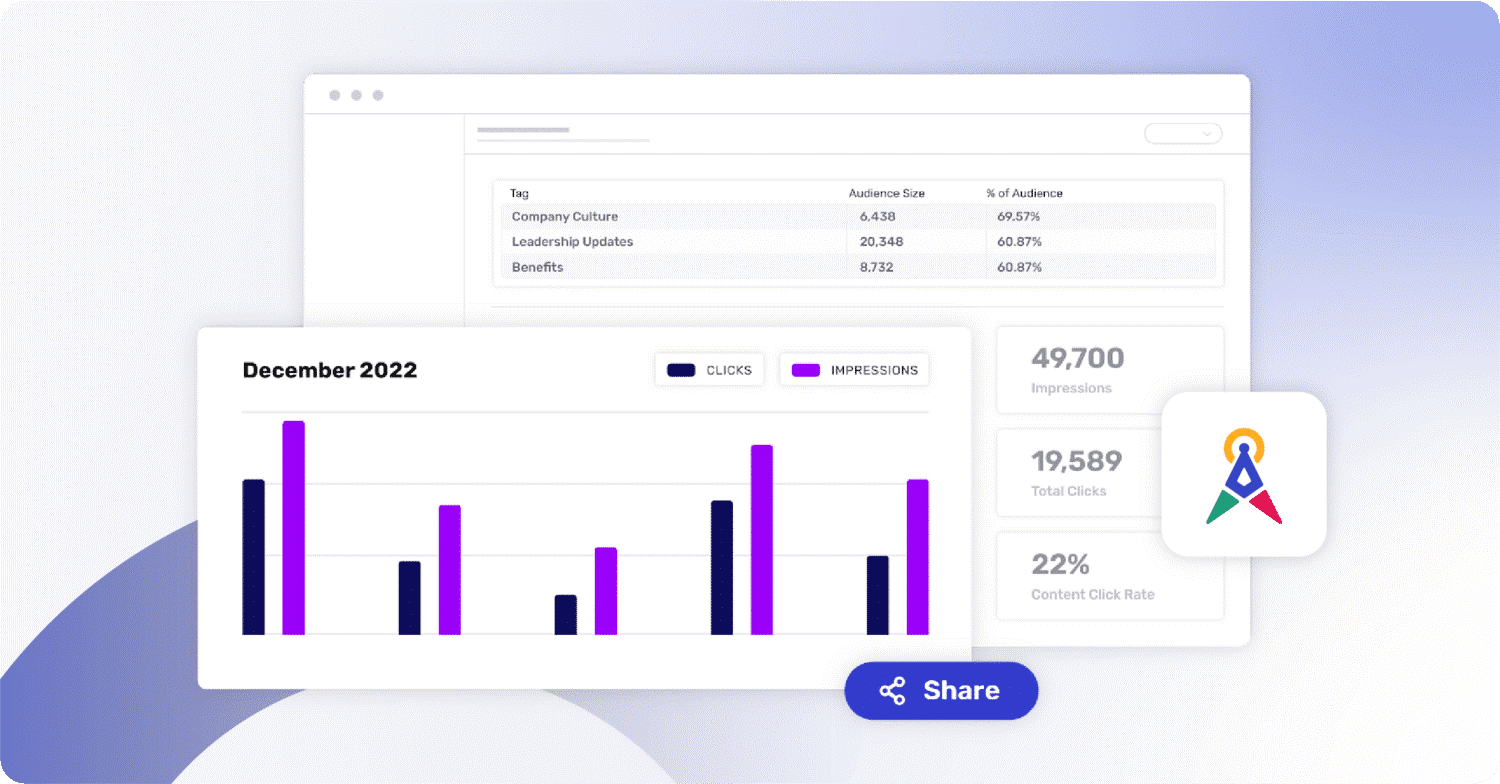
Don’t you love it when a plan comes together? If yours hasn’t yet, we have a free internal communication plan template that you can use to streamline a solution that will dovetail with your organization’s needs. It’s intuitive and ideal for beginners. Optimized for quick planning, it’s easy to use, comprehensive, and adaptable.
Using the free template offers a powerful way to achieve your objectives. It will save you time and effort and provide you with a reliable foundation to guide your communication efforts.

Organize communication objectives and create a clear, well-structured plan that you can adapt over time.
What is an internal communications plan? This is a strategy or plan that organizations often use to make sure they maintain effective communication with employees. To be successful it needs to support the key business outcomes established by the organization.
What should an internal communication plan include? The basic plan should be definitive, but it doesn’t need to be long. It should include identification of the target audience, clearly defined goals and objectives, key messages, and a list of the preferred communication channels. There should also be a content strategy, a timeline, identification of roles and responsibilities, and effective feedback mechanisms. You will need to allocate a budget, and there must be agreement on evaluation metrics to assess the success of the plan.
What are smart goals for internal communications? The smart goals follow the acronym SMART: specific, measurable, achievable, realistic, and timely.
What is the internal communication planning process? IC planning starts with researching your audience and the needs of your organization. Then you need to set objectives, craft messages, choose channels, and create content. After this, you need to implement the plan. Finally, you can collect feedback, measure results, and make any necessary adjustments for future applications.

Organize communication objectives and create a clear, well-structured plan that you can adapt over time.